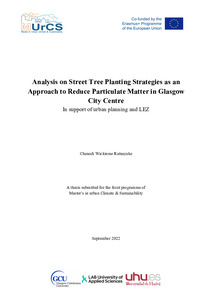Analysis on street tree planting strategies as an approach to reduce particulate matter in Glasgow city centre : in support of urban planning and LEZ
Ratnayake, Chanodi Wickreme (2022)
Ratnayake, Chanodi Wickreme
2022
All rights reserved. This publication is copyrighted. You may download, display and print it for Your own personal use. Commercial use is prohibited.
Julkaisun pysyvä osoite on
https://urn.fi/URN:NBN:fi:amk-2022111122476
https://urn.fi/URN:NBN:fi:amk-2022111122476
Tiivistelmä
Urban air pollution is one of the biggest environmental threats and health concerns of our time. Due to its adverse health effects, particulate matter (PM) is identified as the most frequent and toxic pollutant in cities. With traffic emissions being the major contributor to air pollution in urban areas, protecting the health and wellbeing of the urban population has become a significant challenge for planners. To control air pollution in urban areas, many countries have imposed policies and actions to reduce atmospheric pollutant concentration, emission rates and quantities emitted from sources. In recent years, street vegetation has been identified as an alternative nature-based solution (NBS) to improve the air quality in urban areas. In terms of urban planning, positioning the right vegetation in the right place is vital for air quality enhancement. Therefore, this study aims to critically investigate the role of street vegetation design in improving local air quality in support of urban planning and policy constrains.
In this study, the investigations were narrowed down to a single street canyon in Glasgow City Centre, as it has been identified as one of the most polluted streets in the city. Accordingly, different street tree scenarios and cases were developed based on Glasgow’s 2021 Public Realm Design + Maintenance Guide and Avenues Programme design scheme. Using the three-dimensional microclimate model ENVI-met, the scenarios were evaluated to investigate the impact of different in-canyon placement strategies of vegetations, while the case studies were analysed to understand the impact of common street tree parameters such as tree shape, porosity, size, species, etc. and meteorological parameters such as wind directions, which plays a crucial role in urban street planning and air quality enhancement.
The findings of this research concluded that trees achieve an effective improvement in the air quality in Glasgow City Centre. It suggested that implementing a single row of trees towards the leeward side with significant canopy gaps improve the air quality in the entire street rather than implementing a dense row of trees. However, it also showed some limitations for implementing trees in street canyons based on site conditions, such as the physical geometry and meteorology. Accordingly, placing trees near canyon intersections and building setbacks deteriorates the air quality due to reduced corner eddies and wind speeds. The study gave useful insights on which trees could be placed, and how should they be spaced in Glasgow Street canyons to improve the air quality achieving. The findings of this research which focuses on the optimum street trees planting strategies are complimnetray to the Avenues Programme and can be considered for LEZs to “bridge” the outcomes of air quality mitigation strategies and “co-improve” Glasgow’s air quality for a better future.
In this study, the investigations were narrowed down to a single street canyon in Glasgow City Centre, as it has been identified as one of the most polluted streets in the city. Accordingly, different street tree scenarios and cases were developed based on Glasgow’s 2021 Public Realm Design + Maintenance Guide and Avenues Programme design scheme. Using the three-dimensional microclimate model ENVI-met, the scenarios were evaluated to investigate the impact of different in-canyon placement strategies of vegetations, while the case studies were analysed to understand the impact of common street tree parameters such as tree shape, porosity, size, species, etc. and meteorological parameters such as wind directions, which plays a crucial role in urban street planning and air quality enhancement.
The findings of this research concluded that trees achieve an effective improvement in the air quality in Glasgow City Centre. It suggested that implementing a single row of trees towards the leeward side with significant canopy gaps improve the air quality in the entire street rather than implementing a dense row of trees. However, it also showed some limitations for implementing trees in street canyons based on site conditions, such as the physical geometry and meteorology. Accordingly, placing trees near canyon intersections and building setbacks deteriorates the air quality due to reduced corner eddies and wind speeds. The study gave useful insights on which trees could be placed, and how should they be spaced in Glasgow Street canyons to improve the air quality achieving. The findings of this research which focuses on the optimum street trees planting strategies are complimnetray to the Avenues Programme and can be considered for LEZs to “bridge” the outcomes of air quality mitigation strategies and “co-improve” Glasgow’s air quality for a better future.
